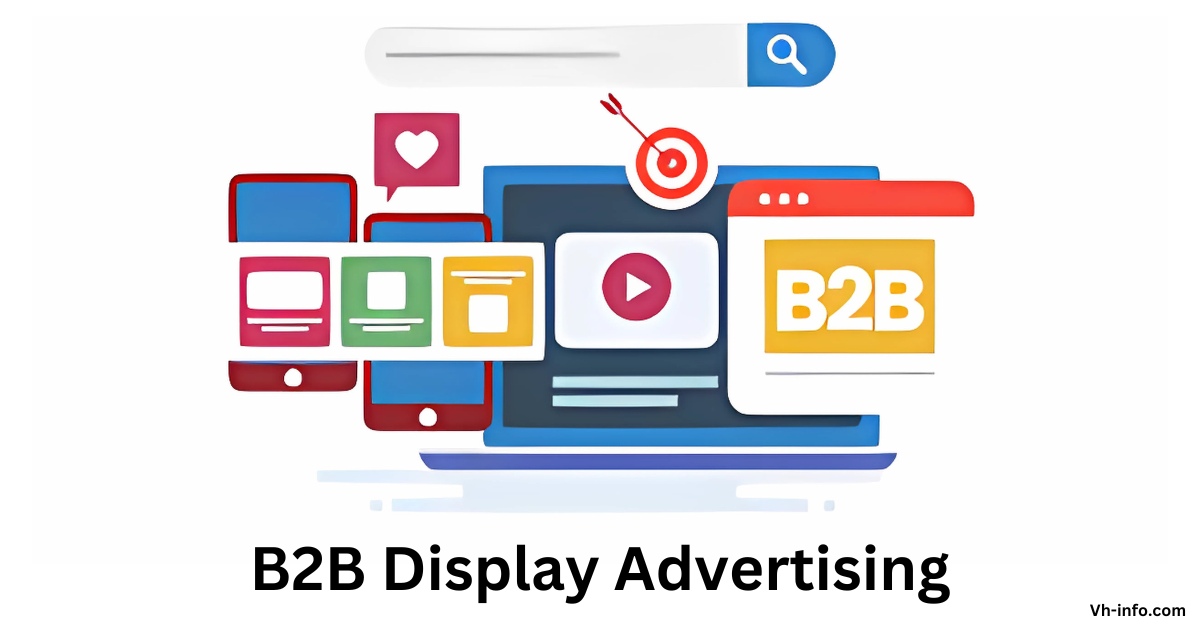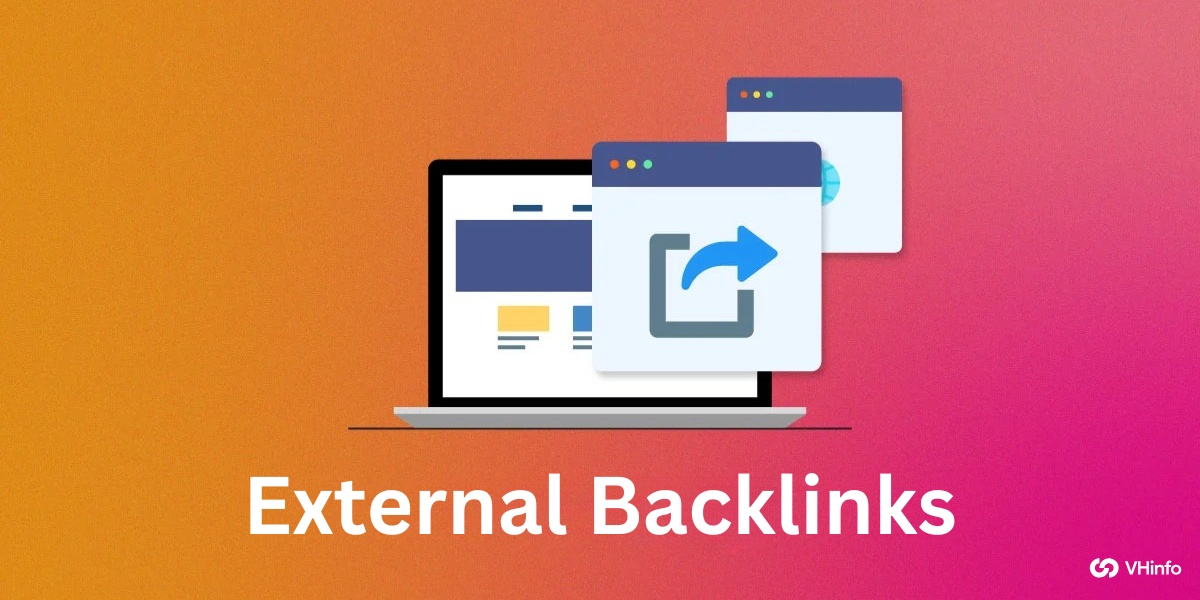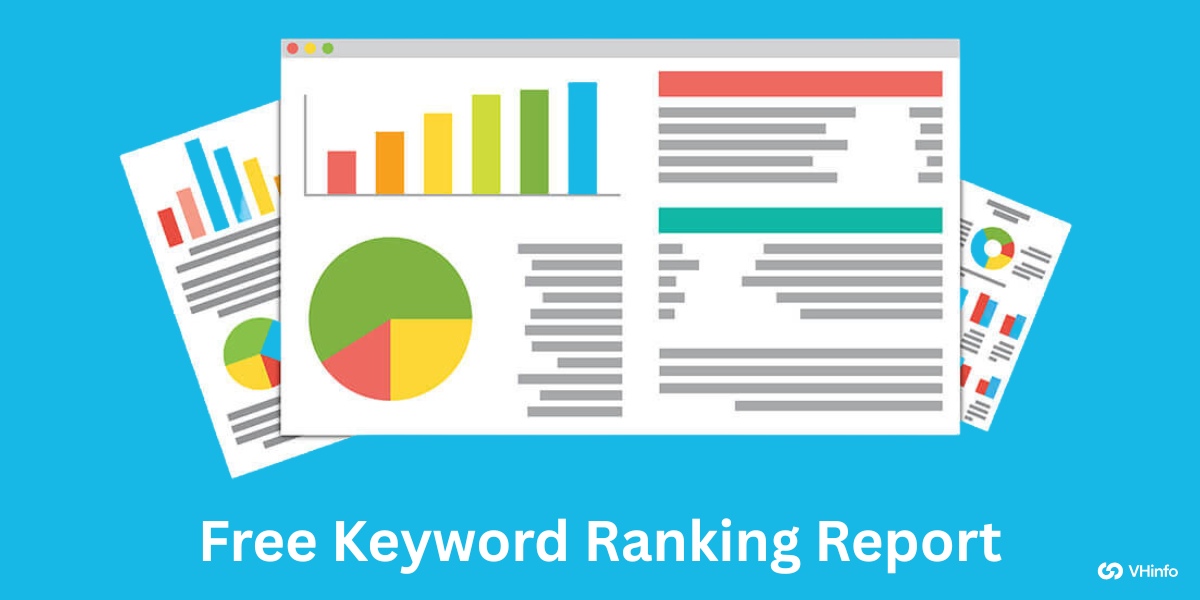In today’s fast-paced digital marketing landscape, B2B companies are constantly seeking effective ways to reach their target audience and generate leads.
Among the many digital marketing strategies available, display advertising stands out as an excellent tool for building brand awareness and driving traffic to your website.
This guide from VH-info will delve into the potential of display advertising for B2B SaaS, offering best practices, strategies, and examples of successful B2B display ads.
What is B2B Display Advertising?
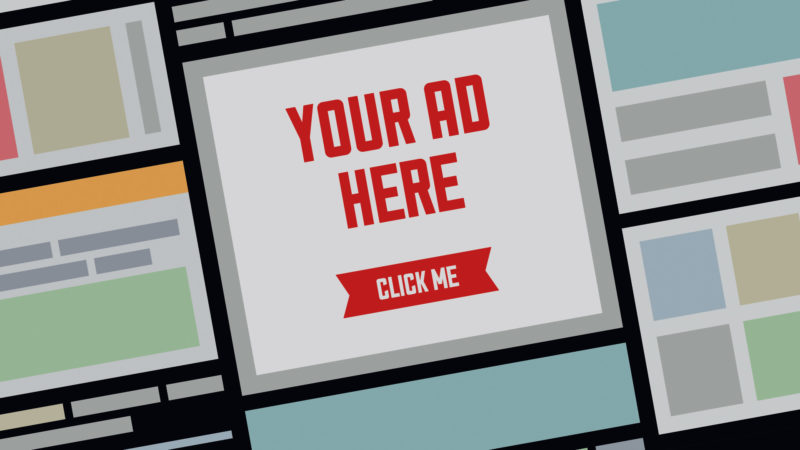
Display advertising is a form of digital marketing that involves placing visual ads on websites, mobile apps, and other online platforms.
These display ads, often in the form of banner ads, are designed to capture the audience’s attention and entice them to click through to a landing page. For B2B companies, display advertising offers a great way to reach specific audiences based on job title, industry, user interests, and other demographic and professional data.
A well-created display ad campaign can significantly boost brand recognition and generate valuable content for prospective customers.
How Does Display Advertising Work?
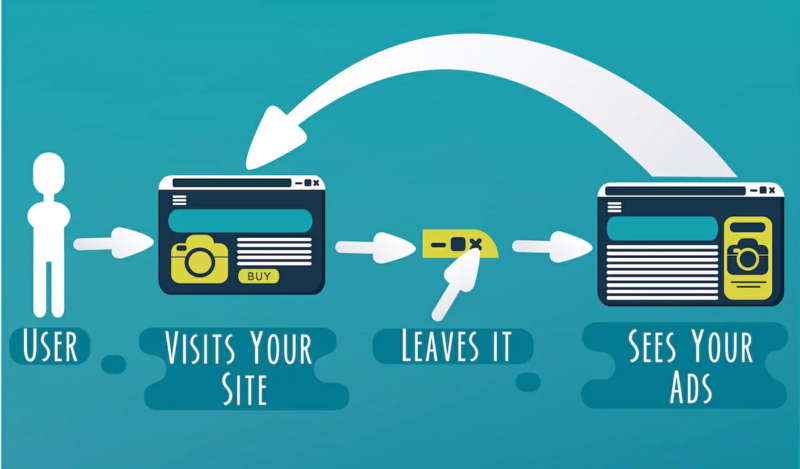
Display advertising operates through ad networks like the Google Display Network and other advertising platforms. Advertisers create ad creatives that align with their marketing campaign goals and specify their ad targeting criteria.
The advertising platform then displays the ad on relevant websites and mobile apps within its display network, based on the user interests, browsing history, and other user behavioral data.
When a user clicks on the ad, they are directed to the advertiser’s landing page, where they can learn more about the product or service and potentially convert into a lead or customer.
Importance Of B2B Display Advertising

Display advertising is important for B2B companies for several reasons:
- Increased Brand Awareness: Display ads help in building brand awareness by exposing a specific audience to your brand image across various online platforms.
- Targeted Reach: With precise ad targeting options, you can reach specific audiences that align with your ideal customer profile.
- Lead Generation: A compelling display ad can drive qualified traffic to your landing page, resulting in lead generation and potential sales.
- Measurable Results: Display advertising allows you to track key metrics such as impressions, clicks, and conversions, providing valuable insights into your ad campaign performance.
Types of Display Ad Formats
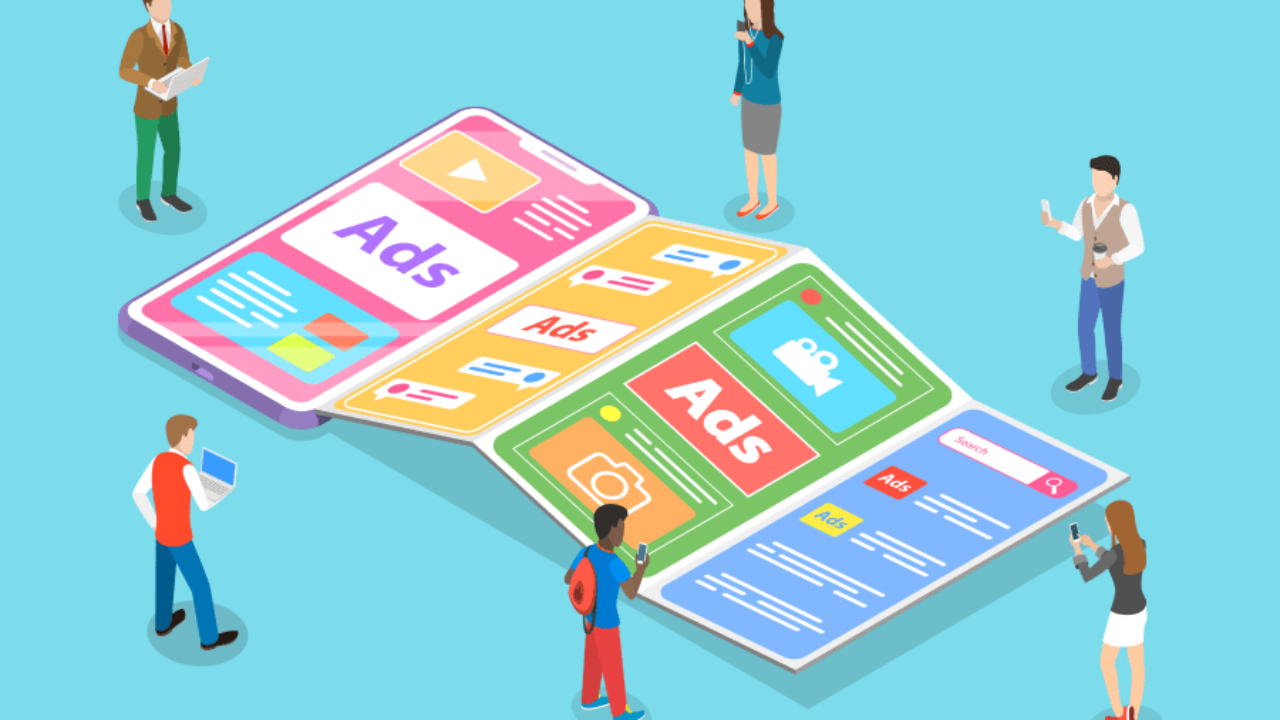
Ad formats are super important for how users experience and engage with your ads.
Here’s a quick look at some common types of display ad formats:
- Animated: These ads use movement to grab the audience’s attention. Think of them as little cartoons within a banner ad space. They’re designed to be eye-catching and can be a great way to stand out on a busy webpage and increase user engagement.
- Interactive: These ads want you to play with them! They might include quizzes, games, or other elements that encourage user engagement.
- Static/Standard: These are your basic image ads – a picture with some text. Simple, but effective if you have a clear message and a strong call to action or “CTA Button is the Key“. They can still contribute to building brand awareness if the ad design is strong.
- Transitional: These ads take over the screen for a few seconds while a webpage is loading. It’s a chance to make a big impression, but make sure your ad design is on point so you don’t annoy people.
- Video: Video ads use the power of sight and sound to tell a story or showcase your product. Video ads tend to be more engaging than static ones.
What Are The Elements Of Effective Display Ad Design?

A strong ad design is super important for a successful display advertising campaign.
Here are some key elements that make a display ad work:
- Ad Sizes: The dimensions of your display ad matter! Certain ad sizes, like the medium rectangle or large rectangle, tend to perform better because they fit well on many websites. Choosing the right size helps you maximize visibility and user engagement.
- Ad Structure: Think of this as the layout of your ad. A well-structured ad presents information in a clear and easy-to-understand way, guiding the audience’s attention to the most important parts.
- Use Top-Notch Images: Visuals are key! Using high-quality images or graphics will grab the audience’s attention and make your brand image look professional. Avoid blurry or low-resolution images at all costs.
- Choosing Colors: Colors can have a big impact on how people feel about your ad. Think about your color scheme and how it relates to your brand. Do you want to evoke excitement, trust, or something else?
- Utilize Contrast: Make sure important elements, like your headline and CTA button, stand out! Using contrast in your ad design helps to draw the eye to what you want people to see first.
- CTA Button is the Key: Tell people what you want them to do! A clear and compelling CTA button prompts users to click on your ad and visit your landing page. Use action-oriented language like “Learn More” or “Free Trial.” It creates a sense of urgency.
- Perfect the Typography: Choose fonts that are easy to read and visually appealing. Your ad copy should be clear and concise, so people can quickly understand your message.
- Seasonality Works: Tailoring your ad creatives to reflect the current season, a holiday, or other timely events can make your ads more relevant and engaging.
- Context Counts: Make sure your ad is relevant to the website or app where it’s being displayed. Ad targeting helps with this, but it’s also important to consider the overall user experience.
- Programmatic Advertising: This is about using technology to automate the buying and selling of display ad space. It allows for more precise ad targeting and real-time optimization of your display advertising campaign.
- Size and File Type: Pay attention to the technical requirements! Adhering to the specified size and file type ensures that your ads are displayed correctly across various devices on the display network.
How To Create Display Ads?
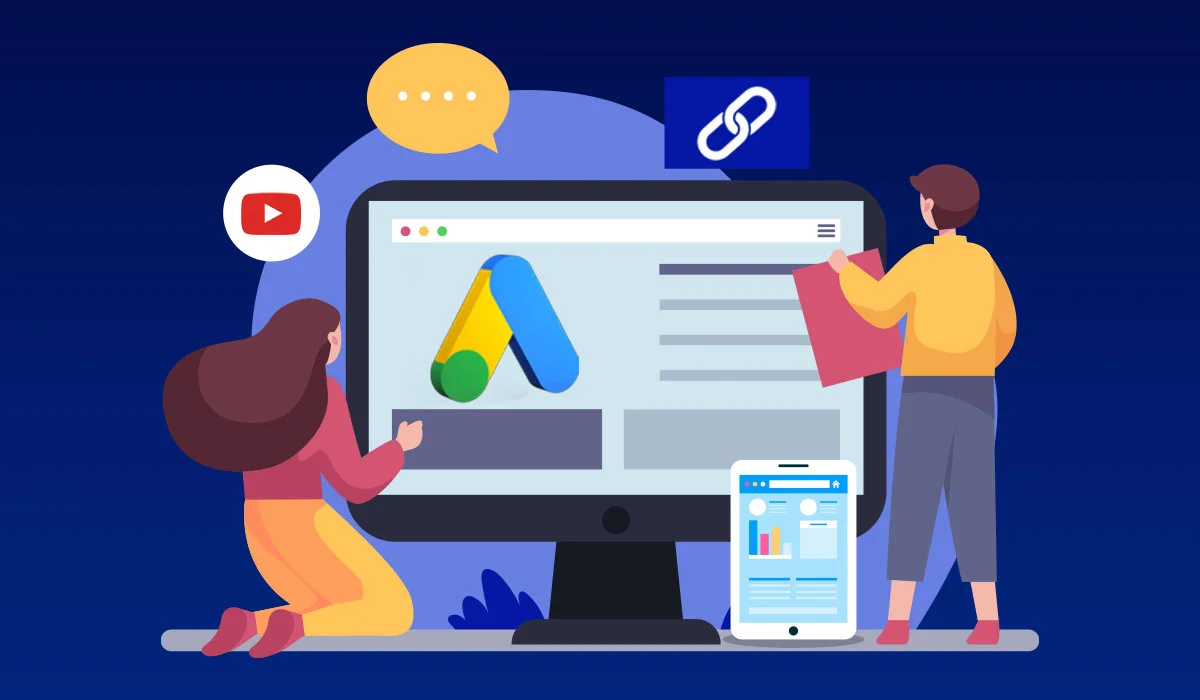
Creating effective display ads involves a few important steps:
- Define Your Audience: Before you even start designing your ad, you need to know who you’re trying to reach. What are their demographics, job titles, interests, and specific pain points? Understanding your target audience is important for effective ad targeting.
- Partner With The Right Publishers: Where your ads appear matters! Choose websites and mobile apps that your target audience visits. This ensures your display ad is seen by the right audience on a relevant online platform.
- Identify and Use Highly Targeted Keywords: Think about what your target audience is searching for online. Using relevant keywords in your ad targeting settings helps ensure your ads are shown to people who are already interested in what you offer.
- Find The Perfect Ad Placement: Experiment with different ad placements on websites and mobile apps. Some spots are more visible than others, so b testing different placements to see what generates the most user engagement.
- Take Advantage of Remarketing: Remarketing (or retargeting) lets you show ads to people who have already visited your website. This is a great way to re-engage potential customers and increase the likelihood of engagement and conversions.
- Choose The Right Platform: Different advertising platforms, like the Google Display Network, offer different ad targeting options and reach different specific audiences. Research your options and choose the advertising platform that best aligns with your marketing strategy.
3 B2B Display Advertising Strategies For 2025

To take your marketing efforts to the next level, consider these B2B display advertising strategies from VH Info:
B2B Display Advertising Strategy #1: Solid Foundations
Start with a strong base. This means having a clearly defined marketing strategy and a deep understanding of your target audience.
Know their unique pain points, their job title, and where they spend their time online. A solid understanding of your target audience and their buyer’s journey will make the ad targeting and ad creative decisions much easier.
B2B Display Advertising Strategy #2: Surround-Sound Messaging
Don’t rely on display advertising alone. Integrate your display ad campaign with other digital marketing strategies, like content marketing, email marketing, and social media.
This creates a cohesive brand image and reinforces your message across multiple channels. When customers see your brand recognition on various devices and social platforms, they’re more likely to remember you.
B2B Display Advertising Strategy #3: A/B Testing
Never stop testing! Continuously b testing different ad creatives, ad targeting options, and landing page designs. See what resonates best with your target audience and optimize your ad campaign accordingly.
A/B testing your ads is the most effective way to improve the user experience and gain maximum impact in a short amount of time.
6 Common Google Display Ad Mistakes To Avoid

To make the most of your display advertising campaign on the Google Display Network, avoid these common mistakes:
- Boring Ad Design: In a crowded online platform, your ads need to stand out! Don’t let your ad design be an afterthought. Make sure your ads are visually appealing, use top-notch graphics, and capture audience’s attention quickly. A boring ad won’t lead to much user engagement.
- No Visual Elements: People are visual creatures! Failing to include images or videos in your display ad is a big missed opportunity. Visuals enhance user engagement, help convey your message, and make your ads more memorable. Don’t forget to optimize your ad creatives.
- Vague CTAs: Your CTA button is important! If your call to action is unclear or weak, people won’t know what you want them to do. Use strong, action-oriented language and create a sense of urgency to encourage clicks and conversions.
- Disorganized Ads: If your ad is cluttered, confusing, or difficult to read, people will likely ignore it. Make sure your ads are well-structured, with a clear headline, concise copy, and a prominent CTA button.
- Weak Content: Your ad needs to offer something of value! Generic or uninteresting content won’t resonate with your target audience. Deliver valuable content that addresses their specific pain points and showcases the benefits of your product or service.
- Lack of A/B Testing: Never assume you know what works best! Continuously test different versions of your ads to optimize performance. Try different headlines, images, CTA buttons, and ad targeting options to see what resonates best with your target audience.
Why is B2B Display Advertising Effective?

B2B display advertising is a powerful tool for reaching specific audiences and achieving your marketing campaign goals.
Here’s why it works:
- They Find Users Where They Are: Display ads appear on the websites, social platforms, and mobile apps that your target audience already uses. This means you’re reaching potential customers in places where they’re already spending their time and attention. It can be a great way to reach the right audience at the right time.
- Targeting Tools Are Improving: Ad targeting options are getting more and more precise. This allows you to reach specific audiences based on demographics, job title, industry, user interests, and other factors. Better ad targeting means less wasted ad spend and a higher likelihood of engagement.
- The Rise of Digital and Mobile: More B2B buyers are using various devices, including smartphones and tablets, to research and make purchasing decisions. Display advertising lets you reach them on these devices, no matter where they are.
- B2B is Becoming More Like B2C: The lines between B2B and B2C digital marketing strategies are blurring. B2B buyers now expect the same personalized, engaging, and seamless user experience they get in their personal lives. This is making display advertising an effective way to appeal to the new generation of B2B buyers.
How Can I Make The Most Of My B2B Display Advertising?

To really maximize the maximum impact of your B2B display advertising campaign, keep these points in mind:
- Know Your Audience Inside and Out: A deep understanding of your target audience’s specific pain points, job title, and user interests is fundamental.
- Create Compelling Ad Creatives: Invest time and effort in creating visually appealing and engaging ads that grab audience’s attention.
- Laser-Focus Your Ad Targeting: Utilize precise ad targeting options to reach specific audiences that are most likely to become customers. The Google Display Network offers many options.
- Create Dedicated Landing Pages: Ensure your ads link to landing pages that are relevant to the ad content and designed to drive conversions.
- Always Include a Clear Call to Action: Use a strong CTA button with action-oriented language to prompt users to take the desired action, creating a sense of urgency.
- Use Remarketing Smartly: Retarget users who have previously shown interest in your products or services with tailored ad messages.
- Track, Analyze, and Optimize: Monitor your ad campaign performance closely, analyze the data, and make adjustments as needed to improve results. Continual A/B testing will help improve your numbers.
- Don’t Forget Mobile: Ensure your ad designs are optimized for various devices, particularly mobile, as many B2B buyers are using smartphones and tablets to research products and services.
- Deliver Valuable Content: Provide educational content and information that addresses your target audience’s unique pain points.
- Think Long Term: Building brand awareness is key, even if immediate conversions aren’t always apparent.
Examples Of Successful B2B Display Ads

Here are some examples of B2B companies that have run successful display advertising campaigns:
Sagefrog & Razor Technology

Sagefrog helped Razor Technology, an IT-managed services provider (MSP), improve its lead generation through a comprehensive marketing strategy that included display advertising.
Creating ad creatives that were both targeted and visually appealing, they effectively reached the right audience, resulting in a surge in digital traffic and a 132% increase in new contacts with key job titles.
This shows how display advertising, when integrated with other digital marketing strategies, can significantly boost brand awareness.
HubSpot

HubSpot is known for its educational content and uses display ads to promote its various offerings. Their display ad campaigns emphasize the value they provide, often highlighting free trials or resources that address specific pain points for marketers and sales professionals.
Providing valuable content shows their target audience the ways they can offer them solutions.
Salesforce

Salesforce likely uses display advertising to target businesses of all sizes, promoting its cloud-based software solutions.
A display ad campaign would focus on lead generation by emphasizing the benefits of its platform, such as improved sales productivity and customer relationship management. Ad targeting would focus on decision-makers in sales, marketing, and customer service roles.

As an advertising platform themselves, Google almost certainly uses display advertising to promote its various products and services, including Google Ads, Google Workspace, and Google Cloud.
It is likely their ad creatives highlight the potential of display advertising on their display network.
Cloudflare

Cloudflare offers web security and performance services, so their display ad campaigns likely target IT professionals and business owners concerned about website security and speed.
Ad messaging may focus on specific pain points such as DDoS attacks or slow loading times, with a call to action to learn more about their solutions. They may utilize programmatic advertising to reach specific audiences on relevant websites and platforms.
Trends in B2B Display Advertising

To stay ahead in the B2B digital marketing landscape, keep an eye on these display advertising trends:
- Personalization: Tailoring your ad creatives and messaging to individual user interests and behaviors is key. This means using data to deliver personalized content and ad experiences to your target audience. If you can adapt your ads to each user’s needs, you will stand out as a solution that truly understands its audience.
- Account-Based Marketing (ABM): Instead of targeting individuals, ABM focuses on reaching key accounts with hyper-specific messaging. In advanced ABM, programmatic advertising is used to target key accounts with very specific messaging. This strategy combines the focused approach of ABM with the scalability of programmatic advertising.
- AI and Machine Learning: Machine learning algorithms can optimize ad targeting, ad placements, and ad creatives, improving the effectiveness of your display advertising campaign. Advertisers can use AI to create ads and then allow machine learning to make necessary changes to best fit their audience.
- Native Advertising: Native advertising blends ads seamlessly into the surrounding content of a website or mobile app, providing a less intrusive user experience. Because people are spending more time on mobile devices, there is a better opportunity for native ads to appear on mobile apps and other online platforms.
- Video Content: Short, engaging videos are becoming increasingly popular in display advertising, especially on social platforms like Instagram and TikTok. Advertisers are using video ads because they are effective, with native video ads topping the list of strategies that boost brand awareness.
- Programmatic Advertising: Programmatic advertising uses data-driven algorithms to automate the buying and selling of ad space, ensuring that your ads reach the right audience at the right time.
- Cross-Device Targeting: Reach your target audience across various devices to create a cohesive brand image and ensure your message is seen no matter where they are.
- Sustainability and Ethical Advertising: With increasing consumer awareness of social and environmental issues, highlighting your company’s sustainable practices and ethical values in your ads can resonate with specific audiences.
- In-App Advertising: As mobile usage continues to rise, ads within mobile apps offer a significant opportunity to reach your target audience. There’s a better chance of engaging more leads because more internet users are using apps on their mobile devices.
- Interactive Ads: Interactive ads engage users through games, quizzes, or other interactive elements, creating a more memorable and engaging user experience. In 2025, interactive display ads will become standard as brands want to engage customers beyond traditional visuals.
Best Practices For Using Google Display Ads For B2B SaaS

To maximize the effectiveness of your display advertising campaign on the Google Display Network, follow these best practices:
- Simple Designs, Non-Boring Content: Keep your ad design clean and uncluttered, but avoid being dull. Use top-notch visuals, clear messaging, and compelling content that captures the audience’s attention and communicates your value proposition effectively. Make sure the design has the potential to increase the likelihood of engagement.
- Create Urgency and Add a CTA Button: Encourage immediate action by creating a sense of urgency in your ad copy and including a prominent CTA button. Tell users exactly what you want them to do, whether it’s “Learn More,” “Free Trial,” or “Request a Demo.”
- A/B Testing Multiple Versions: Don’t rely on guesswork! Continuously test different versions of your ads – headlines, images, CTA buttons, and ad targeting options – to see what resonates best with your target audience.
- Design For Mobile Users: With more B2B buyers using smartphones and tablets, it’s important to ensure your ads are optimized for various devices. Use responsive ads that automatically adjust to different screen sizes, providing a seamless user experience.
- Connect Ads to a Landing Page: Always direct users to a dedicated landing page that is relevant to the ad content and designed to drive conversions. Your landing page should provide valuable content, reinforce your message, and make it easy for visitors to take the next step.
- Optimize With Retargeting Features: Use retargeting to reach users who have previously visited your website or interacted with your brand. This is an effective way to re-engage potential customers and increase the likelihood of engagement and conversions. Tailor your ad messaging to their user behavior and offer them something of value to encourage them to come back.
What Makes B2B Display Advertising Different From B2C Display Advertising?

B2B display advertising differs from B2C display advertising in several key ways:
| Feature | B2B Display Advertising | B2C Display Advertising |
|---|---|---|
| Target Audience | Specific audiences based on job title, industry, and company size. | Broad consumer base. |
| Messaging | Focus on valuable content, industry insights, and ROI. | Focus on emotional appeal, lifestyle, and entertainment. |
| Call to Action | Emphasis on lead generation, free trials, and demonstrations. | Emphasis on immediate purchases and discounts. |
| Buyer’s Journey | Longer and more complex sales cycles. | Shorter and more impulsive purchasing decisions. |
| Metrics | Focus on lead quality, conversion rates, and customer lifetime value. | Focus on click-through rates, website traffic, and sales volume. |
| Social Media Focus | more focus on social media platform that appeal to professionals like LinkedIn | More focus on social media platform like tiktok and X, formerly known as twitter |
FAQ’s:
How Much Should You Budget For B2B Display Ads?
There’s no one-size-fits-all answer. Start with a budget that aligns with your overall marketing campaign goals and gradually increase it as you see positive results.
Consider factors like your target audience size, ad targeting options, and the competitiveness of your industry. It’s also smart to consider which advertising platform you plan to use.
How Often Should I Update My B2B Display Ads?
Keep your ads fresh to avoid ad fatigue.
Update your ad creatives regularly – at least every few weeks – with new images, headlines, and offers. Also, make sure you are b testing different ad types often. This will allow you to engage your target audience and keep your ad design relevant.
How Do I Know If My Display Ad Design Is Working?
Track key metrics like impressions, click-through rates (CTR), conversion rates, and lead generation numbers. Use A/B testing to compare different ad variations and identify what resonates best with your target audience.
If your CTR is low, you may need to fix your ad design or ad targeting settings.
Can Display Ads Drive More Traffic To My Website?
Yes! A well-executed display advertising campaign can significantly increase website traffic and brand recognition.
Make sure your ads are visually appealing, relevant to your target audience, and linked to a dedicated landing page that provides valuable content and encourages conversions. They can be a great way to reach the right audience at the right time.
Conclusion
B2B display advertising is an effective way to building brand awareness, generate leads, and drive traffic to your website.
Checking out the awesome tips in this guide and keeping in the loop with the latest trends, you can totally make the most of display advertising to crush your marketing campaign goals.
With the extensive reach of ad networks and the ability to target specific audiences, B2B display advertising can be an excellent tool in your digital marketing strategies.
